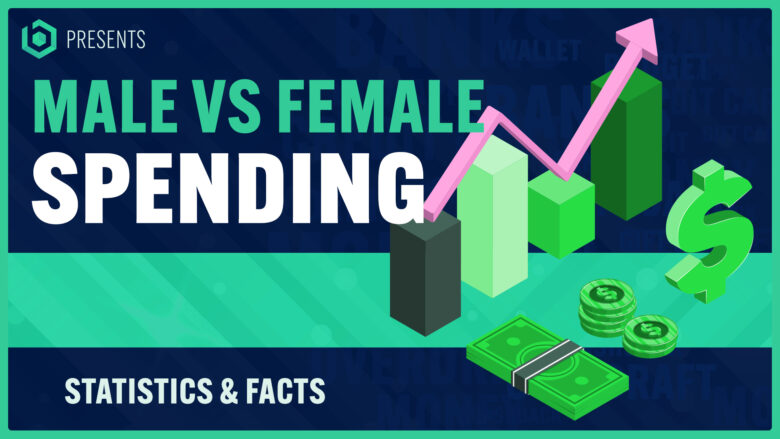Confused about how men and women differ in their spending habits? Consider this: Women control over an eye-popping $31.8 trillion dollars of worldwide spending! This blog will navigate you through the intricate labyrinth of male vs female spending statistics, shedding light on who spends more on groceries, vehicles or even Valentine’s Day gifts.
Curious to find out more? Let’s dive in!
- Women control an astounding $31.8 trillion in worldwide spending, showcasing their significant economic influence.
- Men tend to outspend women on annual purchases, with an average yearly expenditure of $35,018 compared to women’s $33,786.
- There are notable differences in online marketplace spending between genders, with men shopping more frequently and purchasing non-essential items such as electronics and toys.
- Women typically spend more on groceries each month than men, with an average monthly expenditure of $323 compared to men’s $290.
- Men tend to spend significantly more on meals than women, with an average spending per meal of $21 compared to women’s $14.
- Women generally have a higher clothing expenditure than men, averaging 76% more annually on apparel and accessories.
- Men spend more annually on vehicles ($2,900) compared to women ($1,670), influenced by lifestyle changes and income levels.
- Men also outspend women when it comes to audio and visual equipment ($835 vs. $725).
- Women spend over twice the amount that men do on pet care annually (women: $488 vs. men: $206).
- Health expenditure reveals gender discrepancies between ages 18 and 44, with women bearing higher costs for personal care products and healthcare services.
Overview of Male vs Female Spending Differences

Men and women display noticeable differences in their spending habits, including disparities in average annual spending, online marketplace purchases, and grocery expenses.
Average annual spending
As a comparison, the spending habits of men and women differ significantly on a yearly basis.
| Gender | Average Annual Spending |
|---|---|
| Men | $35,018 |
| Women | $33,786 |
Single men have the edge in outspending single women. Men’s spending accounts for a yearly average of $35,018, as opposed to women who spend an average of $33,786 annually. However, it’s worth noting that women control a staggering $31.8 trillion in global spending. In the long run, both genders play significant roles in economic stimulation and growth.
Online marketplace spending
Online marketplace spending habits significantly differ between men and women. Notably, the statistics reveal that men tend to shop online more frequently, and their preferences include Amazon and Walmart. Additionally, men tend to buy more non-essential items such as electronics, toys, and games.
| Online Marketplace | Male Spending | Female Spending |
|---|---|---|
| Amazon | Higher Frequency | Lower Frequency |
| Walmart | Higher Frequency | Lower Frequency |
| Non-Essential Items | More Likely to Purchase | Less Likely to Purchase |
However, women are not far behind in online spending, with 36% of women likely to spend more on goods from online marketplaces. These patterns indicate that while men tend to dominate online marketplace spending, women are catching up swiftly. The digital age has brought about substantial changes in consumer behavior, reflecting different spending habits between genders.
Grocery expenses
In the arena of grocery expenses, there appears to be a significant difference between men and women. On average, women tend to spend more on grocery items, approximately $323 each month, compared to men who average around $290 per month. This suggests that women handle more of the household grocery shopping and meal preparations, attributing to their higher average monthly spend.
| Gender | Average Monthly Grocery Spending |
|---|---|
| Men | $290 |
| Women | $323 |
These numbers are interesting to consider, given the differing roles and responsibilities of men and women in various households. However, they represent averages and not every individual will fall into these exact figures. It’s important to remember that each person’s spending habits are influenced by a number of factors, including income, lifestyle, and personal preferences.
Discrepancies in Spending Categories

Lunch and dining expenses show a notable difference between men and women, with men spending an average of $21 while women spend around $14.
Lunch and dining expenses
One significant difference in spending habits between men and women centers on lunch and dining expenses. Studies show that men tend to spend significantly more on meals than their female counterparts.
| Gender | Average Spending per Meal |
|---|---|
| Men | $21 |
| Women | $14 |
This discrepancy in spending on meals may be attributed to several factors. Men’s generally higher income levels and greater workforce participation could encourage them to spend more on eating out. Furthermore, societal expectations and gender roles may also contribute to these spending habits. Meanwhile, women, who are traditionally more engaged in household chores, may prefer to prepare meals at home, contributing to their lower expenditure on dining. The table above illustrates the average spending per meal for both genders, highlighting this significant difference. It is important to note that these statistics represent averages and may not convey individual or specific circumstances.
Clothing expenditure
There is a significant difference in the annual expenditure on clothing between men and women.
| Gender | Average Clothing Expenditure |
|---|---|
| Men | Less than 24% of annual clothing budget |
| Women | Approximately 76% more than men on annual clothing budget |
Women’s preference for variety in their wardrobe along with the desire to stay up-to-date with current fashion trends contribute greatly to this expenditure. Surprisingly, this trend is observed regardless of the economic status of the women. Likewise, single men are also not lagging behind in spending on clothes with their expenses touching near $35,018 per year. Contrastingly, women also make up a large portion of the workforce and control over $31.8 trillion dollars in worldwide spending, which further amplifies their purchasing power in the clothing sector.Overall, the data clearly shows that women’s expenditure on clothing is significantly higher than men.
Vehicle purchase disparities
Vehicle purchase disparities between men and women show significant differences. Although both genders purchase vehicles, spending trends vary.
<table border=”1″>
<tr>
<th></th>
<th>Men</th>
<th>Women</th>
</tr>
<tr>
<td>Average annual spending</td>
<td>$2,900</td>
<td>$1,670</td>
</tr>
<tr>
<td>Lifestyle changes impacting vehicle purchases</td>
<td>Higher due to pet adoption, childbirth, and home buying</td>
<td>Lesser impact</td>
</tr>
<tr>
<td>Income and employment contribution</td>
<td>Higher levels of workforce participation and higher income</td>
<td>Lower levels of workforce participation and less income</td>
</tr>
</table>
Men’s higher annual spending on vehicles is evident. Life changes like pet adoption, childbirth, and home buying also influence these purchases. Men’s higher workforce participation and income level contribute to this spending difference. Despite these disparities, both genders contribute significantly to the automobile sector.
Audio and visual equipment spending
Men and women differ significantly in their approach to audio and visual equipment spending.
| Gender | Average Annual Spending on Audio and Visual Equipment |
|---|---|
| Men | $835 |
| Women | $725 |
Men’s spending on such equipment is higher when compared to women. They splurge an average of $835 annually on audio and visual offerings. Women, on the other hand, tend to be a bit more conservative in this sector, spending roughly $725 per year.
Pet care costs
Pet care is an area where spending significantly diverges between men and women. According to important data, on average, women spend $488 per year on pet care, which is more than double of men’s average spending of $206 in this category. This indicates a considerable gender-based spending gap in this sector.
| Gender | Average Annual Pet Care Expenses |
|---|---|
| Women | $488 |
| Men | $206 |
| Data shows women spend more than double on pet care annually compared to men. | |
Different factors including emotional connection, responsibility perception, and consumer behavior might contribute to this stark difference in pet care expenditure.
Age and Health Related Spending

In terms of health expenditure, individuals aged 18 to 44 tend to spend more than those in other age groups. Valentine’s day also brings about increased spending habits among both men and women.
Additionally, there are noticeable changes in weekly expenses as people grow older.
Health expenditure from ages 18 to 44
The health expenditure between the ages of 18 and 44 reveals significant gender discrepancies, with women usually bearing higher costs.
| Age Group | Men’s Annual Spending | Women’s Annual Spending |
|---|---|---|
| 19-34 | Average expenditure not specified | $3402 more than men |
| 35-44 | Average expenditure not specified | $2199 more than men |
These higher costs for women can be attributed to a variety of factors. Women bear the extra cost of personal care products and services. They also tend to pay more for healthcare services. Over their lifetimes, women’s healthcare costs amount to $526,374 more than men’s. Added to this, the so-called “pink tax” contributes to the higher costs women face, as products targeted toward women are often priced more expensively.
Valentine’s day spending habits
Valentine’s Day is often marked by excessive spending on romantic gifts and experiences.
| Item Category | Average Spending by Men | Average Spending by Women |
|---|---|---|
| Jewelry | $350 | $85 |
| Dining | $200 | $75 |
| Flowers & Cards | $55 | $35 |
| Chocolates & Sweets | $30 | $20 |
The table above illuminates the spending trends between genders on Valentine’s Day. Men tend to spend more on jewelry and dining, while both men and women roughly spend the same amount on flowers, cards, chocolates, and sweets. The average spending for men is significantly higher in certain categories, further emphasizing the divergence in spending habits between genders on special occasions.
Changes in weekly expenses
In terms of weekly expenses, there are notable variations between men and women when it comes to spending habits. According to research, on average, men tend to spend more money than women in 2021. This trend is particularly evident in the purchase of non-essential goods such as electronics, toys and games, and tobacco. Factors such as differences in income and employment contribute significantly to these spending disparities, with men typically having higher levels of workforce participation and earning more income compared to women. These discrepancies highlight the importance of considering gender dynamics when analyzing consumer behavior and financial management strategies.
Consumer Behavior and Spending Patterns
Consumer behavior and spending patterns vary significantly between men and women, influencing their purchasing decisions across various categories. From toy and accessory expenses to home purchases, these differences shed light on intriguing spending habits.
Discover more about how gender impacts consumer buying trends in our comprehensive analysis.
Toy and accessory expenses
Men and women have different spending habits when it comes to toys and accessories. According to statistics, men tend to spend more on non-essential items such as electronics and gaming consoles, while women prioritize purchases for their children, including toys and educational materials. On average, men spend around $500 per year on toys and accessories, while women allocate approximately $300 annually. It’s interesting to note that both genders prefer the same retailers for these purchases, with men shopping more at electronics outlets like Apple and Best Buy, whereas women opt for big-box retailers like Target and Kohl’s. Additionally, men are more likely to use social media platforms such as Instagram, YouTube, Facebook, and TikTok for product searches in this category. This data reinforces the notion that gender plays a role in consumer behavior when it comes to toy and accessory expenses.
Home purchasing statistics
In terms of home purchasing statistics, it is worth noting that men tend to have a slightly higher likelihood of owning homes compared to women. According to the U.S. Bureau of Labor Statistics (BLS), 65% of men own their dwellings, while only 61% of women can say the same. This could be attributed partly to factors such as lower mortgage rates and a historically greater workforce participation among men. It is important to emphasize that this statistic does not imply that women are less financially capable or interested in homeownership; rather, it reflects some of the structural barriers and inequalities faced by women in certain sectors. Nonetheless, both genders should thoroughly evaluate their options when looking at homeownership, considering factors like affordability and long-term financial stability.
[Word Count: 141]
Gym and fitness accessory spending
Women significantly outspend men when it comes to gym and fitness accessories, with an average spending of $33,786 per year compared to men’s $35,018. In fact, women contribute a staggering $15 trillion to the economy through their spending habits. When it comes to apparel and accessories related to fitness, women spend 76% more than men each year. This indicates that women are not only investing in their health but also in looking good while doing so. It is important to note that these spending patterns may be influenced by income and employment disparities between genders. Interestingly, during the pandemic, men’s incomes have experienced less negative impact compared to women’s incomes, which could affect their ability or willingness to invest in gym and fitness accessories.
Spending habits within the 45 to 54 age group
Individuals in the 45 to 54 age group exhibit interesting spending habits. According to recent data, men tend to spend more money compared to women within this age range. In fact, their spending surpasses that of women by a considerable margin. This could be attributed to various factors such as higher incomes or different priorities when it comes to expenditure. Additionally, men in this age bracket are more likely to engage in online shopping on a daily and weekly basis, particularly on popular platforms like Amazon and Walmart.com. They also tend to purchase a greater number of non-essential goods, including electronics, toys and games, and tobacco products. These spending patterns shed light on the divergent consumer behaviors exhibited by individuals in this particular demographic group.
Source: Forbes
Savings and Financial Management
In terms of savings and financial management, it is important to note that men tend to prioritize retirement saving more than women.
Retirement saving tendencies
Men and women have different approaches when it comes to saving for retirement. According to important statistics, men tend to prioritize retirement savings more than women. On average, men contribute a higher percentage of their income towards retirement funds compared to women. This could be due to various factors such as differences in earning potential and financial responsibilities. It’s worth noting that despite these disparities, both genders are encouraged to save for retirement early on in order to secure their financial future. Taking advantage of employer-sponsored retirement plans and seeking professional advice can help individuals better understand their options and make informed decisions regarding their retirement savings.
Importance of financial support in family settings
Financial support plays a crucial role in family settings, particularly when it comes to achieving balanced spending habits. With women spending almost twice as much as men each month on apparel, accessories, and cosmetics, it highlights the need for effective financial management and support within families.
This is further highlighted by the fact that single men outspent single women slightly, underscoring the importance of equitable financial support and savings strategies. Additionally, women control over $31.8 trillion dollars in worldwide spending, emphasizing the significance of responsible spending and savings practices supported by strong financial management within families.
By addressing potential imbalances in income and employment between genders through financial support, families can ensure more responsible and sustainable spending habits while fostering equal participation in managing household finances.
Our Takeaway
In conclusion, the statistics clearly show that there are significant differences in spending habits between men and women. Women tend to spend more on apparel, accessories, and cosmetics, while men outspend women when it comes to vehicle purchases.
Understanding these discrepancies is crucial for businesses looking to target specific consumer groups effectively. By tailoring marketing strategies and products towards these spending patterns, companies can optimize their sales and appeal to a wider audience.
Article Sources & Helpful Links
Here are some helpful links that may help you learn more:
- Marketplace: The pandemic drove people to buy more online – An article discussing the shift in buying habits due to the pandemic.
- SUNY Geneseo: Meeting Expenses – A page from SUNY Geneseo detailing how to manage meeting expenses.
- WalletHub: Valentine’s Day Facts – A page providing statistics and facts about Valentine’s Day spending.
- Apple: iPhone 13 – The official Apple page for purchasing the iPhone 13.
- Apple: iPhone Trade In – Apple’s official page detailing how to trade in your old iPhone for credit towards a new one.
- Nike Help Center – The official help center for Nike, providing support and contact information.
Male vs Female Spending Statistics (FAQs)
How do men and women spend differently?
Men and women tend to spend money differently due to various factors such as societal norms, gender roles, and financial goals.
Do women spend more than men?
Studies have found that women spend an average of 30% more than men on products and services.
Do women prefer online shopping?
Yes, women are more likely to prefer online shopping compared to men, primarily due to convenience and accessibility.
Are single women more likely to spend than single men?
According to research, single women tend to spend more on clothing, dining out, and beauty products than single men.
How do men and women differ in their spending habits?
Men tend to spend more on electronics, gadgets, and hobbies, while women prioritize spending on clothing, health and wellness, and home decor.
Do women pay more attention to prices while shopping?
Yes, studies have found that women are more price-conscious shoppers and are more likely to make purchasing decisions after comparing prices across different stores.
Do men and women share similar financial goals?
While men and women tend to have similar financial goals such as saving for retirement and building wealth, their approaches to money management may differ based on personal circumstances and values.
How much money do women account for in consumer spending?
Women account for approximately 70-80% of consumer spending in the United States.
Do men earn more than women?
On average, men earn more than women, which can impact their spending habits and overall financial outlook.
Do women prioritize long-term financial goals?
Studies have found that American women nearing retirement age are more focused on saving and investing for their long-term financial goals than men in the same earnings bracket.




